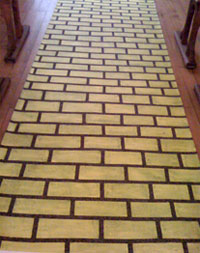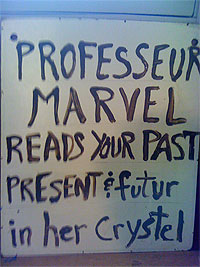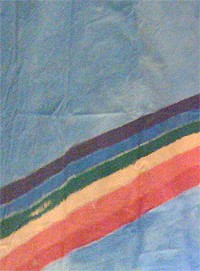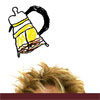Behind the Curtain
“The tricky part is right here, after the storm in Kansas,” De-facto said, pointing to the creased sheet of paper that had been folded and stuffed in his back pocket, removed and unfolded, again and again. These were the set change instructions and they looked relatively simple, which was what worried me. He was in charge of the sets for the performance; he’d crafted and painted many of them, built the stage extension and choreographed the scene changes with the director. His crib notes made sense, to him.

I’d been in the audience the night before, the opening night of the school’s English section performance of The Wizard of Oz. I know it’s easy for proud parents to crescendo their praise to a distorted level, but I think I am not exaggerating when I report that the production was a first class piece of children’s theater.
A truly dedicated group of parents, affectionately named the Yellow Brick Road Crew, started the engine on this production way back in March. The director of the play, a multi-dexterous woman with talent and tact motored it forward with a professionalism that far exceeded her volunteer status. The rehearsals started as a Saturday morning activity. Then Sundays were added, then Wednesday afternoons, too, as the dates of the performance drew near. Lines were memorized by small, elastic brains, songs transposed and rehearsed until they could be sung by heart. Dance steps were choreographed, even practiced by adults in the café, trying to figure out how four kids might skip together arm-in-arm on a narrow stage. A week earlier, the dress rehearsal for their classmates was chaotic and choppy – as a first full run-through in costume with sets usually is – and even then, the teachers and peers were seriously impressed. But the real test was opening night, in front of a (paying) audience of adults, teachers and family members. The debut was a glowing success, acclaimed by all the spectators who were present, many I suspect, who had come with modest expectations. It was, after all, just a primary school play.
Except it was so much more. Yes, the sets were low budget, sheets of calico painted by harried (but artistic) parents and a few exceptionally obedient children. The lights (operated by a father in oven-mitts) and mikes were borrowed and jerry-rigged. The costumes were puzzled together on a shoestring budget (though brilliantly executed). But it was the actors who really brought the stage to life: twenty-some kids under the age of eleven, who’d learned not only their lines, songs and dances, but also memorized their cues for entering and exiting – no small feat because in order to give more children parts in the play, there were multiple actors for many of the roles: five Dorothys, three Scarecrows, three Tin-men, two Wizards. One actor would exit stage left, her replacement would appear through the center of the curtain at the start of the next act. Short-pants was Glinda in act two, after the house lands in Oz, and then the Scarecrow in act  three. This called for a high-speed costume change during the song “We’re off to see the Wizard,” as Dorothy (played at that point by Buddy-roo) and the munchkins (played by a gaggle of kindergartners and first graders) danced on the yellow brick road.
three. This called for a high-speed costume change during the song “We’re off to see the Wizard,” as Dorothy (played at that point by Buddy-roo) and the munchkins (played by a gaggle of kindergartners and first graders) danced on the yellow brick road.
Short-pants has a natural temperament to be the Good Witch of the North and there was a sweet and special chemistry on stage with her sister (who was truly lovely as Dorothy), but it was in the role of Scarecrow that she really found her stride. It was like she able to access the part of her that really is the Scarecrow, that slightly clumsy, brainy, loyal, lovable friend. During her solo number, as she side-stepped across the stage singing “I could think of things I never thunk before,” my throat got all lumpy and choked up and my eyes got a little teary.
The casting had been handled marvelously, every child had a chance to try every role (although we learned only recently that Buddy-roo refused to read for any part other than Dorothy). Then the kids were seriously coached. They weren’t just reciting their lines, the director had drawn each actor into his character. She’d guided, suggested and cajoled to help them breathe life into their parts. But she also got out of the way to let each child interpret the characters on their own, and let their creativity come out. The children were clearly having a great time. This was observable and palatable; you could feel how much fun they were having on stage.
I think most of us in the audience were in awe: of the actors, of the director and the transformation she’d alchemized, of the world-class musical parents, who did more than accompany the performance; their music was like a soft blanket underneath, supporting the kids without ever upstaging them. We were in awe of the people behind the scenes, committed parents who were sorting costumes and props, working lights and projectors. (De-facto even donned a green wardrobe to blend in with the cast while hanging scenery.) This was a real show. 
With a good performance under their belt, a bit of feedback (speak louder, project to the back of the room), the kids seemed confident and excited to have another go for the final show. My role, on night two, was to sit with the littler actors and help to keep them quiet between their munchkin scene and at the point when they’d all wrap themselves in green satiny capes to become the citizens of the Emerald city. But the guy who’d partnered with De-facto on the sets the night before expressed a desire to see his child in the performance, so I volunteered to switch duties with him. He briefed me and it seemed clear enough. Besides, I was working with De-facto. We work together all the time.
“After shaking the curtains for the storm,” De-facto said, “put out the props and then you have to run to blow the bubbles for Glinda.” My eyes were glazing over as I was reading through his set instructions, trying to make sense of the timing. Much of what we had to do happened between acts: changing the background scenery, placing or turning a painted cardboard tree on the stage, putting the witches legs out under the house; but it had to happen quickly and at the right time. In some cases, the only cue to help me was the previous line in the script, so I knew what I had to do, I just wasn’t always sure exactly how long before I had to do it.
The curtain shaking (“shake them hard,” he’d said, “but not so hard that you knock over the sets,”) went well and before I knew it we were blowing bubbles, a pointless act, really, as my little bubbles hardly flew far enough on to the stage to be seen and the giant-bubble releaser he was blowing through only seemed to work when he was practicing with it backstage. It was a minute later that our friend, the guy who’d worked with De-facto the night before, snuck backstage and said, “where are the legs?”

The legs! I ran for them, slipping and falling, toppling Dorothy’s suitcase under the prop table. We managed to push the legs out under the set of the fallen house, fortunately in time for the moment when the wicked witch turns to them and tries to pull the ruby slippers off and they recoil back under the house.
At least I’d messed up on the scene with my own kids. But I didn’t want to mess it up for any others. My confidence shattered, I pestered De-facto for the rest of the show, “Now? Do I do it now?” It was comical, how the two of us were running around changing sets and props. At one point we were holding the curtain back to create a great-and-powerful shadow effect for the wizard and I noticed the heavy (and possibly dangerous) canister of helium at the edge of the prop table, on the verge of falling onto the floor where it very easily could have rolled out on to the stage. I couldn’t reach to move it, the shadow of my arm would have been visible to the audience. I pointed to the table and mouthed to him, “the helium” but he couldn’t make out what I was saying. “What?” he mouthed back, fumbling over the table, touching every item on it but the helium can. Mouthing unintelligible words back and forth, our faces wrinkled in masks of confusion and frustration. If we could have spoken, we’d surely have been screaming at each other. “What?” “Grab the helium can for Christ’s sake!”
A frenzy of activity between each act, and then the lull before the next set or prop change, during which we’d stand around laughing hysterically at ourselves. I mean, we’ve produced some complicated events for our clients, but here we were scrambling to keep up. It was the Wizard of Oz, after all, a story we both knew by heart. How hard could it be? Then all of a sudden, the act would finish and we’d be scrambling again. At one point a costume crisis – key elements of the wizard’s garb went missing – had us running around like chickens with our heads cut off in search of a turban hat and the sequined cape, a panic which made De-facto late for one of his cues.
Having been in the audience the night before, I knew it wasn’t the end of the world that I’d missed the cue on the legs. If you weren’t seated in one of the front rows, you couldn’t even see them. At least they appeared in time for the moment they were most needed. I think our crazy panic during most of the show was contained back stage. Though we couldn’t see it, we knew what was happening on stage was another fantastic performance. The kids were awesome, each one of them giving something of themselves to the audience, in a poignant song, a creative gesture, a comical dance or an ear-piercing scream. What a gift they gave us, our little thespians.

What a gift, from the Yellow Brick Road Crew, all the time and attention given to our children so they could have a real theater experience, filled with all the hard work and risk and exhilaration that come with acting.
What a gift, to the parents. Despite occasional complaints about lost weekends and schlepping to all the rehearsals – even for those of us who were involved only on the periphery, it felt like it took a lot of time – this production brought us closer together. We bonded. I got to know people I didn’t know before, and the ones I knew, now I know them more. I have developed a deeper respect and affection for the other parents at the school; all it took was a make-believe storm in Kansas to help me see that all these amazing people have been there all along, right in my own back yard.


June 13th, 2011 at 3:19 pm
Hi..I so relate to this. Tricia joined a theater group after seeing Annie the first time. We are still close friends with all the parents. It was a wonderful bond. Happy Summer. hugs, Betty
June 15th, 2011 at 7:33 pm
Aw, this is the sweetest thing ever.
Despite having worked in theater-y organizations for ever, I’ve never worked backstage…
June 20th, 2011 at 6:07 pm
What a wonderful experience and post! I love theater, especially children’s theater. You made it all come alive in your writing.